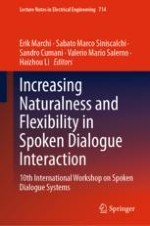2021 | OriginalPaper | Chapter
RSL19BD at DBDC4: Ensemble of Decision Tree-Based and LSTM-Based Models
Authors : Chih-Hao Wang, Sosuke Kato, Tetsuya Sakai
Published in: Increasing Naturalness and Flexibility in Spoken Dialogue Interaction
Publisher: Springer Singapore
Activate our intelligent search to find suitable subject content or patents.
Select sections of text to find matching patents with Artificial Intelligence. powered by
Select sections of text to find additional relevant content using AI-assisted search. powered by
